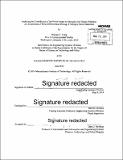Reducing the contribution of the power sector to ground-level ozone pollution : an assessment of time-differentiated pricing of nitrogen oxide emissions
Author(s)
Craig, Michael T. (Michael Timothy)
DownloadFull printable version (10.95Mb)
Other Contributors
Massachusetts Institute of Technology. Technology and Policy Program.
Advisor
Mort D. Webster.
Terms of use
Metadata
Show full item recordAbstract
Nitrogen oxide (NOx) is a prevalent air pollutant across the United States and a requisite precursor for tropospheric (ground-level) ozone formation. Both pollutants significantly impact human health and welfare, so National Ambient Air Quality Standards (NAAQS) have been established for each. As of 2013, over 100 million people in the U.S. lived in areas with ozone concentrations above the NAAQS. NOx emissions from the power sector, roughly 12% of total NOx emissions, are and will be significant contributors to ozone concentrations in the U.S. As such, states have reduced peak ozone concentrations through technology-based standards and cap-and-trade programs on NOx emissions from the power sector. These policies have largely treated NOx emissions uniformly. But marginal damages from NOx emissions are greatest on hot sunny days when meteorological conditions favor high ozone formation rates and, consequently, peak ozone concentrations. This thesis informs what type of policy is the most efficient for reducing peak ozone concentrations on high ozone days by assessing the cost-effectiveness of three policies for reducing NOx emissions on high ozone days. Emissions and costs under a relatively-novel differentiated policy, time-differentiated pricing, are compared for the first time to two currently-implemented undifferentiated policies, cap-and-trade and technology-based standards. Two power systems are studied, Texas and the Mid-Atlantic. A unique two-phase model is developed to capture the short- (re-dispatching) and long-term (control technology installation) effects of pricing schemes on power plants. The two-phase model dispatches generators with a unit commitment model, which, unlike past studies, captures real-world operational constraints of generators that may strongly influence emissions and costs under time-differentiated pricing. Technology-based standards are simulated via Monte Carlo analysis to capture the uncertain rule-making process. For reducing NOx emissions on high ozone days in both power systems, time-differentiated pricing is shown to be the most cost-effective policy with regards to producer and consumer costs. Most emissions reductions are due to substitution of gas- for coal-fired generators, as control technology installations are only observed at very high time-differentiated prices. For reducing summer-wide NOx emissions, undifferentiated pricing is the most cost-effective. In a minority of allocations, technology-based standards also achieve more cost-effective summer-wide reductions than time-differentiated pricing, but such allocations cannot be guaranteed ex ante. These results suggest that time-differentiated pricing is the most efficient policy for reducing peak ozone concentrations, depending on ozone formation rates.
Description
Thesis: S.M. in Technology and Policy, Massachusetts Institute of Technology, Engineering Systems Division, Technology and Policy Program, 2014. Title as it appears in MIT commencement exercises program, June 2014: Reducing the contribution of the power sector to peak concentrations of ground-level ozone: an assessment of time-differentiated pricing of nitrogen oxide emissions. Cataloged from PDF version of thesis. Includes bibliographical references (pages 95-102).
Date issued
2014Department
Massachusetts Institute of Technology. Engineering Systems Division; Technology and Policy ProgramPublisher
Massachusetts Institute of Technology
Keywords
Engineering Systems Division., Technology and Policy Program.